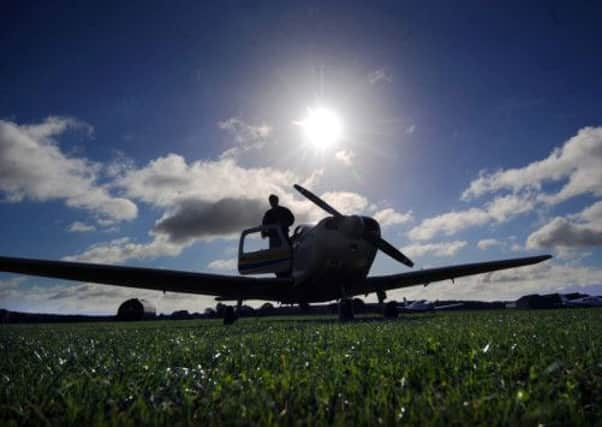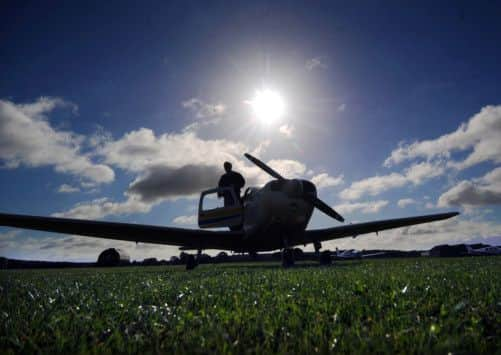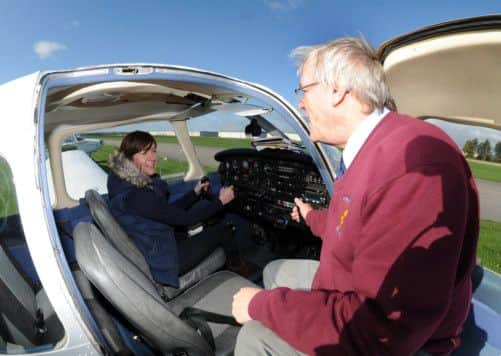Video: Could you land a plane, if you had to?


How difficult is it for a complete novice to land a plane?
Chris Stringer doesn’t hesitate. “Very,” he says. “Without guidance it’s impossible, with guidance it’s almost impossible. The hard bit is not flying the plane. That’s just a machine, like a car. The hard bit is the fact you’re in a different world. As a land animal, everything you have learnt so far goes out of the window. You have to think in three dimensions rather than two and that’s not easy.
“We grow up in a world which is defined by curbs and white lines. Up there, it’s just one big empty space. There’s nothing to guide you, you have to look around.”


Advertisement
Hide AdAdvertisement
Hide AdWe’re at the Sherburn Aero Club where, as chief instructor for the last seven years, Chris has taught dozens of people how to fly. It takes on average 50 hours in the air to go from beginner to qualified pilot. The very basics are taught without leaving the runway and in the countless lessons which follow, every procedure is drilled so thoroughly it becomes as natural as putting a car seatbelt on.
It’s landing a plane which most find hardest to master. Partly it’s down to having the kind of confidence which only comes with time spent in the air. However, it’s also a technically demanding manoeuvre which is learnt step by tiny step.
It’s what makes what happened in the skies above Humberside last week all the more incredible.
It was shortly after 6.20pm on Tuesday when an emergency response was declared after John Wildey, a passenger in a light aircraft, which had taken off from Doncaster, radioed a Mayday call. His pilot and friend had collapsed in the cockpit. They were the only two on board the Cesna 172 and Mr Wildey was at best an inexperienced flyer.


Advertisement
Hide AdAdvertisement
Hide AdWhile he had some rudimentary knowledge of light aircraft controls, he’d never flown a plane before, but with the drama happening thousands of feet in the air, there was only one route to safety – he had to attempt a landing.
It was flight instructor Roy Murray who found himself with the responsibility of guiding the plane down onto the runway at Humberside Airport, but all his careful instructions would have counted for nothing had Mr Wildey not kept his nerve in the most testing of circumstances.
Yet somehow, despite flying in the dark with no lights, he did manage to land the plane at the fourth attempt. Coming down with “a right bump”, it may not have been a textbook landing, but the plane suffered only minor damage to the propellor and the man who had so unexpectedly found himself in control of the cockpit walked away without so much as a scratch.
Sadly the pilot, who has not been named, was later pronounced dead, but those involved in the drama know that they were close to witnessing a double tragedy.
Advertisement
Hide AdAdvertisement
Hide AdBack at Sherburn, Chris is showing me around one of the club’s fleet of Piper Warriors. It’s not dissimilar to the aircraft involved in the Humberside incident and within a few minutes we have carried out the pre-flight inspection and are climbing into the skies of West Yorkshire at the rate of 600ft a minute.
Unlike on a large passenger jet, in this small four-seater plane you’re only too aware of your surroundings. Coasting at 2,000ft, below us the A1 snakes it way from Doncaster on the horizon, passed Knottingley, Garforth and onwards to Wetherby. Not much separates us from the clouds.
“You don’t tend to think of south, north, east and west when you’re on the ground, but it becomes pretty obvious up here,” says Chris, who in a few minutes time will talk me through landing the plane. “As in any emergency situation, it is important to keep calm. Most planes these days are fitted with a transponder, known as a squawk. Should things go wrong, it’s where you send the 7700 Mayday alert.”
That will trigger an emergency response, but before a search and rescue team is able to scramble a helicopter and any radio help is in place, Chris says the key to keeping your head is to ignore the complex-looking instruments and instead fly the plane using the horizon, one big natural spirit level.
Advertisement
Hide AdAdvertisement
Hide AdKeeping the wings straight and the nose level is easier said than done. As Chris hands over control, it turns out the plane responds to even the slightest touch of the lever which operates the wing flaps and the pedals which turn the rudder.
Staring straight down at the fields below after banking sharply left, it’s impossible to envisage how we will get from up here to down there. However, as the plane stabilises again, Chris offers some words of reassurance.
“Aeroplanes like this are based around a very simple system,” he says. “Once full, the fuel tanks have enough for about five hours flying time so there is no need to rush. The first thing you need to do it not only get used to the controls, but trust the person giving you instructions. One of the most important things is not what you tell them, but what you don’t tell them. The last thing you want is to add confusion to an already stressful situation.
“What you do need to know is that even if everything on the plane fails, it is still entirely possible to glide into land.”
Advertisement
Hide AdAdvertisement
Hide AdBy way of proof, Chris, who says he has never had to use the Mayday signal, but did once activate its slightly less urgent cousin, known as the pan-pan, when one of his four cylinders failed, tells me to close the throttle. Silence. But instead of dropping like a stone, the aircraft gently floats below the clouds.
It’s the very definition of suspended animation, but there’s no putting off the inevitable. As au fait as I’m ever likely to be with the controls it’s time to descend. Sherburn is not ideal for a novice. The runway is short – about 500m – and to get there you have to fly over a former mineworks. It’s already a windy day and that part – just a short distance before landing will be turbulent.
“Doncaster or Humberside both have well lit, long runways, which would allow someone with very little experience to get the plane lined up from 15 to 20 miles out. We don’t have that luxury, but the trick is to keep the wings level, while holding the nose up. It’s the latter part that takes the real nerve.”
He’s right. Concentrating on the wings the nose goes down. Pull it back and it feels as though you’re about to land vertically tail first.
Advertisement
Hide AdAdvertisement
Hide Ad“Do you ever see a bird land on its beak?” says Chris. “The aim is to land on the plane wheel rather than the nose wheel, which is really only there to keep the propellor from hitting the ground. When we are instructing we want people to land as smoothly as possible as it helps build confidence. In an emergency situation those concerns go out of the window. No one is going to be worried about a bit of damage to the aeroplane.”
Within a few minutes 2,000ft have been reduced to just a few metres. The ground is almost touching distance, but here comes the difficult part. To avoid serious damage to his plane, Chris takes control of the finer points of landing, while I hold the wing lever dead straight. The thought of being in charge does wonders for your concentration and in a blink of an eye the plane wheels make contact with the ground. There’s a slight bump and that’s it. We’re down.
Could I have done it for real? Who knows? When pushed, ordinary people do achieve some extraordinary feats. Last week Mr Wildey became one of them.